Content
Peony-like flowers are a good substitute for those new to floriculture. The fact is that they are quite demanding in care and maintenance. But there are a number of plants that outwardly are very similar to peonies, while being unpretentious. All of them have dense double flowers of an unusual shape with a delicate aroma, for which they are popular.
What flowers look like peonies
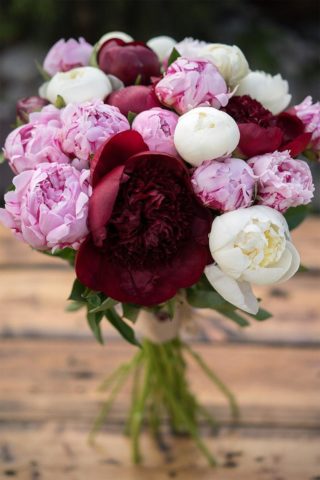
Peony is a popular perennial crop suitable for cutting
Peony is a perennial shrub. He has beautiful decorative leaf plates, a long root, flowers up to 25 cm in diameter. About 5000 varieties of herbaceous peonies and more than 500 tree-like varieties are officially registered.
The varieties differ in the duration of flowering, the size of the bush, the structure, the shade of the flower, the size of the bud. Popular colors are pink, raspberry, white, yellow and orange. The peony has very good compatibility with many cultures, thanks to which it is actively used in landscape design. However, there are many names for flowers similar to peonies.
Ranunculus
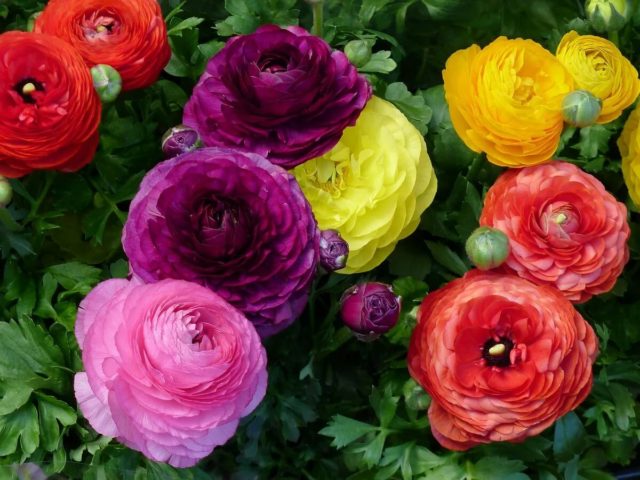
Ranunculus is called the flower of brides
This peony-like flower is called ranunculus. It looks quite impressive, so it is often used to decorate loggias, balconies, gazebos and terraces. The height of the bush sometimes reaches 80 cm. The shoot is strong, the leaf plate is dissected, the root system is in the form of tubers.
Florists grow different varieties and hybrids of ranunculus. To achieve a beautiful flowering, you must adhere to some rules. Experts warn that the roots of the plant are very sensitive and can be burned with some fertilizers. It is better to use those that contain vermicompost. The culture reacts painfully to the transplant, so the place for it must be determined immediately. For the full flowering of ranunculus, it must be provided with limestone and potassium. For a longer period of budding, experienced growers remove the pot with the plant in a dark place and reduce watering. It is also necessary to prune in a timely manner after the flowering period.
How peonies and ranunculus are similar, how they differ
The flower is very similar to a peony. It can also be double, double and semi-double. The color is very diverse, like the peony. Flowers of purple, blue shades are not found. The diameter of the ranunculus is much smaller - 5-10 cm. The buds open gradually, starting from May to August. The leaf blade differs sharply from the green mass of the peony.
Peony roses
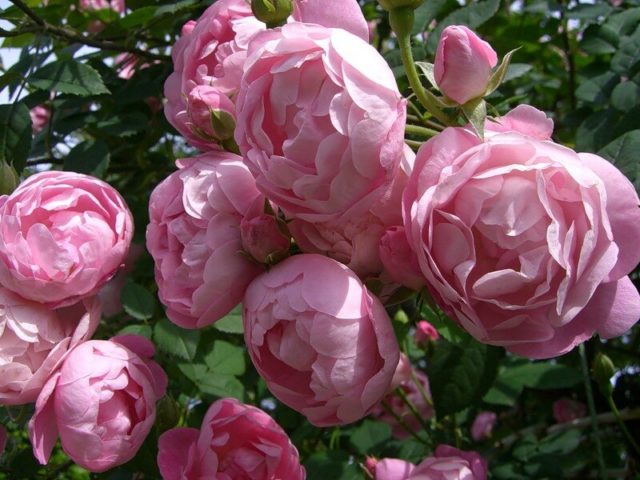
The English rose is widely used in landscaping
Another flowers that are very similar to peonies are called peony or English roses (pictured). The culture was created in England by David Austin. Once the famous breeder was fascinated by old varieties of roses at one of the exhibitions and took part in the formation of new colors, instilled in them resistance to diseases and pests.
Peony roses are a versatile plant. It is used to create flower beds, hedges, as a decoration for swings, gazebos and entrance groups.These roses can be grown both outdoors and in pots.
How peonies and peony roses are similar, their differences
Many people note that the English rose flower looks more like a peony. Its diameter is more than 15 cm, the bud is round, rather lush. Differs in a variety of shades and aroma. There are also significant differences on the part of the leaves - they are much smaller in the rose.
Terry cloves
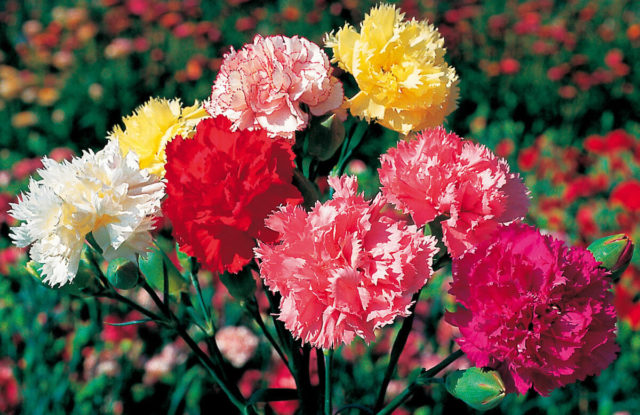
The Shabo carnation variety is most similar to a peony.
Carnation is a perennial plant with a huge number of varieties and hybrids. Some of them are very similar to peonies. For example, terry. Flowers of this culture can be single or grouped on one shoot in several pieces. The petals are densely arranged, have a velvety appearance with a slight fringe. The color of the flowers is diverse. Some types of cloves have medicinal properties.
Carnation propagates by layers and seeds. It is recommended to plant it in sunny, well-lit areas. For planting in open ground, you will need a special soil with peat, river sand and turf. A carnation does not behave well if it has been growing in one place for more than 5 years. She needs a timely transplant. Well tolerates winter without shelter.
What is similar to a peony and what are the differences
Peony varieties include the Shabo hybrid. Its flowers are small but peony-like. The leaf plates are completely different, in a carnation they are narrow and straight, its flowering period is much longer. The shade of the flower can be one color or consist of several flowers. The hybrid smells very good, especially in the evenings.
Peony poppy
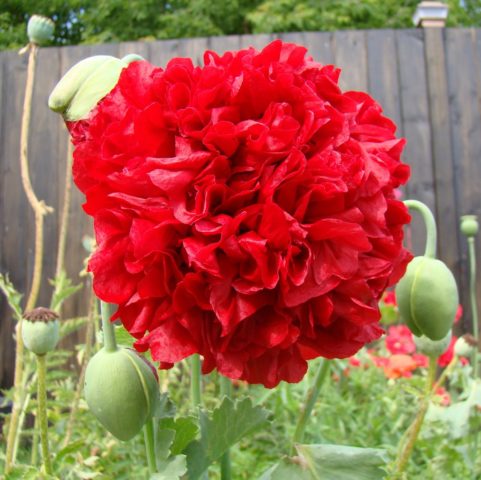
Peony poppy or papaver can multiply by self-seeding
The culture has another name - papaver. The plant is annual and has been bred to resemble a peony. Florists plant it on the sunny side of the site in early spring, trying to make a deep hole, since the root system of the plant is pivotal. Propagated by cuttings or seeds. Prefers moderate watering, requires top dressing for leaves and lush flowering. The peony poppy is used for mixborders, lawns and cutting.
Similarities and differences from peony
It differs in that it belongs to annuals. Has a powerful root system. Terry inflorescences are large, but the color of the plant is not rich - pink shades prevail. Duration of flowering is about a month. Another difference is the ripening of the capsule fruit with small black seeds.
Dense double tulips

Flowers of some tulip varieties are valued for a terry basket
Tulips are bulbous plants, perennials. They are not demanding in care and maintenance, for which they are popular with flower growers. Some terry hybrid varieties are very similar to peonies. The peculiarity is in the structure of the bud, which has the shape of a wide cup. Such varieties are the result of many years of breeding work. Compared to parental specimens, they are more sensitive to environmental influences and diseases.
How peonies and double tulips are similar, how they differ
The similarity lies only in the shape of the flower. As for the difference, crops differ in flowering duration, breeding methods, housing conditions and shades.
Pompon varieties of chrysanthemums
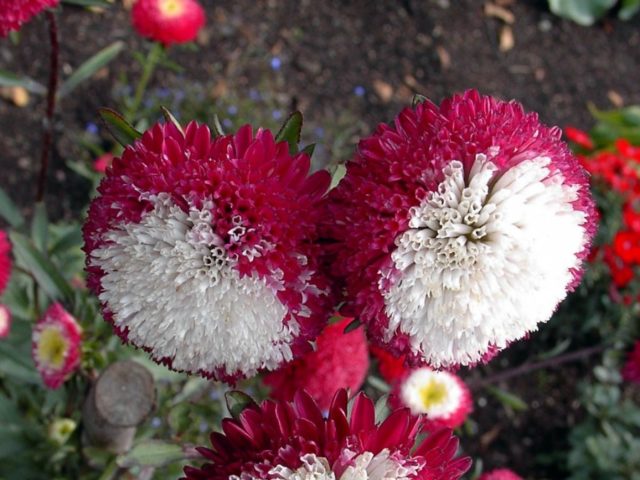
Chrysanthemum is the most popular culture among gardeners, which looks like a peony.
Chrysanthemum is native to Asia and reached Europe in the 18th century. This culture has a thousand-year history.Among the flowers there are perennial and annual varieties. Most varieties and hybrids can be grown outdoors in temperate climates, but there are varieties that require greenhouse conditions. The most valuable specimen for gardeners is the large-flowered and small-flowered perennial chrysanthemum.
In Chinese medicine, chrysanthemum flowers are used as a remedy for migraines, diseases of the digestive system. In some Asian countries, the stems and leaves are added to food as a seasoning.
Similarities and differences with a peony
The similarity with a peony flower is highly doubtful. However, some varieties do resemble it. This applies to a number of hybrid varieties, the petals of which are collected in many rows, forming a terry basket. Chrysanthemum has a variety of shapes and shades, it is completely unpretentious in care.
Eustoma
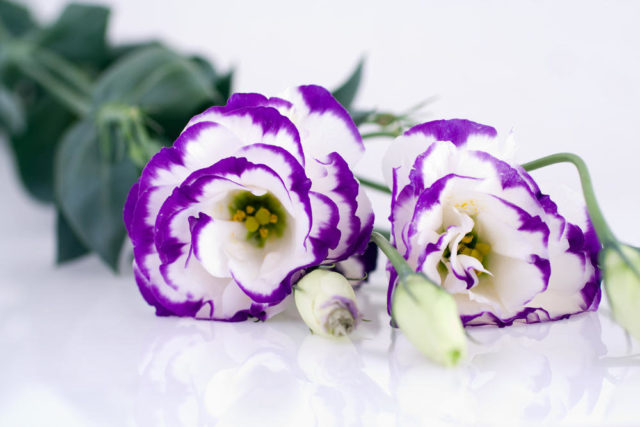
Eustoma has many varieties and hybrids, it has an extraordinary color
Another flower that looks like a peony is called eustoma. He is a real decoration of the garden. It has delicate shades of flowers up to 7 cm in diameter. The plant has become a home plant quite recently, thanks to the efforts of Japanese breeders. Now eustoma is more resistant to diseases and pests, undemanding to care. It is noteworthy that the stems of the plant are tall, branching towards the end, which is why they resemble a bouquet.
For good flowering, she will need a lot of diffused light, fresh air, watering, but without stagnant moisture. Also, for proper development, the plant will need top dressing and timely pruning after flowering.
Similarities and differences from peonies
The flowers, which have not yet fully blossomed, are very similar to peonies. The similarity is observed in the structure of the bud and the tall, strong stem, and the shades of the eustoma are much more varied. Peony is more like terry varieties and hybrids.
Conclusion
Flowers that look like peonies are very diverse in color, methods of care and content. Some can be grown outdoors and in a pot. Many of them are completely unpretentious, while the rest need to be adjusted. But they are all beautiful and noteworthy.








